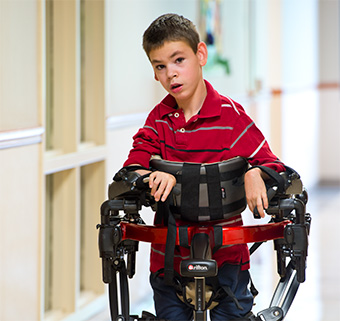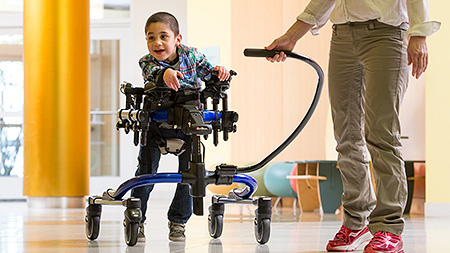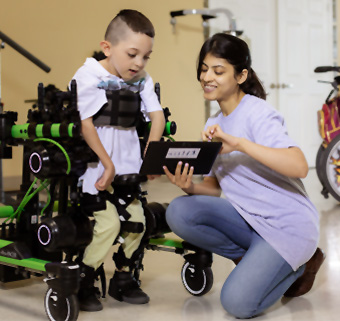Pacer Prompt Reduction: Part 2
Prompt Reduction Strategies
| July 2019See also: Part 1: Concepts for Mobility Skill Building .
Use only the components that the individual requires for walking posture and alignment. Every individual is unique, and therefore prompt reduction should be customized to the individual.
The prompt reduction approaches shown below will also work with the Pacer in the posterior configuration . Posterior positioning may be appropriate for individuals who benefit from facing the open side of the upper and base frames, enabling interactions with their environment.
The casters can be configured to help individuals adjust to new configurations. Every step in prompt reduction requires more effort and concentration. Stabilizing or regulating the motion of the Pacer allows the individual to focus on walking and maintaining alignment. Engage the swivel lock on the two rear casters to eliminate lateral drift, or on all four casters to obviate the need for steering altogether. The one-way ratchet control permits forward movement only. The variable wheel drag individually slows each caster, to decelerate the Pacer if needed. Or, temporarily lock the casters for standing practice.
Example A: Leg Control Achieved Before Trunk Control
In this particular example, the individual achieves leg control prior to gaining core trunk and postural control.
 |
The MPS, the chest prompt, and the arm prompts all help to provide weight bearing assistance and can be positioned to place the client in a forward leaning position. Alternatively, the hip positioner or pelvic support may be used for weight bearing assist. |
 |
With enough practice opportunity, the individual will learn to control stride length and keep feet separated. At this point, the ankle prompts can be removed. |
 |
When the individual is able to keep knees separated, the thigh prompts can be removed. (Note: In many cases, the arm of the MPS saddle provides sufficient abduction for leg separation so that the thigh prompts are not necessary.) |
 |
When the individual demonstrates the ability to bear weight while taking steps, remove the MPS. If the individual requires a hip support for fall safety, use the pelvic support positioned low enough that it does not provide weight-bearing assist. The individual may continue to require the forward leaning position to partially off-weight the legs by leaning forward on the chest prompt and arm prompts. Close supervision is required when doing a trial with no weight bearing assist. As core postural control improves, lower and loosen the chest prompt, and reduce anterior tilt. When the individual is able to take steps and move forward, he or she may no longer require the forward leaning position to achieve movement. Consider turning the chest prompt upside down to place it even lower and nearer the hips. |
 |
When core trunk control is adequate, remove the chest prompt. If possible, remove the arm prompts last, to encourage development of postural balance control. The arm prompts can be placed so that the individual’s elbows are directly below the shoulders, and shoulders aligned above hips, knees and feet. Encourage hand grasp without use of straps on the arm prompts. |
 |
As arm control, core strength and postural control improve, transition to handholds on the frame. The handholds can be placed in an anterior or posterior position. Many individuals will graduate from the Pacer to another walker or to walking independence. |
Example B: Trunk Control Achieved Before Leg Control
In this particular example, the individual achieves trunk and postural control prior to gaining leg control.
 |
The MPS, the chest prompt, and the arm prompts help to provide weight bearing assistance and can be positioned to place the client in a forward leaning position. As core postural control improves, lower and/or loosen the chest prompt so the individual does not rely on it more than necessary. |
 |
When the individual has sufficient core strength and no longer requires trunk support, the chest prompt can be removed. The forward-lean position with weight bearing assistance may continue to be helpful, to promote forward momentum and to stimulate stepping. |
 |
When the individual is able to take steps and move forward, he or she may no longer require the forward leaning. Observe the individual’s stepping ability as well as core and trunk postural strength to decide when to adjust the prompts for a more upright stance. Then align the shoulders over the hips, knees and feet. Weight bearing assistance is still provided, and thigh prompts and ankle prompts assist leg separation and step-taking control. The individual progresses toward further improvement of postural control and weight-bearing ability. |
 |
As weight-bearing ability through the legs improves, and the individual no longer requires the MPS for transfer, replace it with the hip positioner. This will combine assisted weight bearing with increased movement of the pelvis and further challenge the individual’s posture and leg control. |
 |
The thigh prompts may be removed when the individual is able to keep their knees separated while taking steps, and no longer turns or twists the body position within the frame. |
 |
The ankle prompts may be removed when the individual is able to keep their feet apart and/or when they can control their stride length. As weight bearing further improves, the hip positioner can be lowered to serve as a safety sling. |
 |
As soon as individual is fully weight bearing, remove hip positioner completely. Close supervision is required when doing a trial with no weight bearing assist. If possible, remove the arm prompts last to encourage development of postural balance control. With further progress, try using the arm prompts without straps. |
 |
As the individual improves arm control and core strength and postural control, transition to handholds on the frame. The handholds can be placed for use in an anterior (forward) or posterior (backward) position. Many individuals will graduate from the Pacer to another walker, or to walking independence. |
Please note: This description does not replace the direct personal involvement and guidance of a medical professional.
Refer to this checklist to make sure individuals are properly positioned in their gait trainers.





